新人教版七年级上册英语教案_Unit6
- 格式:doc
- 大小:88.00 KB
- 文档页数:10

单元教案Do you like bananas?教材依据:新目标英语七年级上册第六单元教学目标(一)语言知识1、词汇:本单元所要求掌握的所有词汇2、日常交际用语:Do you like …? Yes,I do./No, I don’t.I /They like oranges. I/They don’t like bananas.She likes salad. She doesn’t like salad.3、教学重点:1、掌握各种不同的有关食物方面的名词;2、实义动词like 一般现在时的否定式、疑问式及其答语;3、助动词do /does和don’t/doesn’t的用法;4、一日三餐的营养搭配5、小短文的写作4、教学难点:1、Affirmative and negative statements2、Countable nouns and uncountable nouns3、How to talk about likes and dislikes(二)语言技能学生能认识及听懂各种不同的食物名称,区分可数名词和不可数名词,并能自由表达出自己喜欢和不喜欢的食物;能根据单元所学句型自编对话,讨论自己及他人喜欢和不喜欢的食物并扩展到其他方面(如sports),能进行小组讨论并用英语进行简单的陈述(I like…, I don’t like …,he likes…,he doesn’t like….),能进行一日三餐的营养搭配,能根据课前任务收集和整理资料,并对所得资料进行加工和处理,在课堂中合理地加以运用。
(三)学习策略通过学习课文,掌握有关饮食方面的词汇,并结合所学单词,自由讨论喜好。
通过在课文中交流彼此的特长和爱好,培养群体意识,并在小组讨论及合作中,学会合作学习与研究性学习,完成所给任务,努力开拓课程资源。
(四)情感态度激发学生英语学习的欲望和兴趣,敢于用英语进行交流和表达; 营造情感交融的良好氛围,努力提高学生的学习兴趣,学生自主学习、主动合作;认真完成课前任务,在调查中充分发挥自身潜力,培养思维能力、动手能力、开展研究性学习;(五)文化意识能了解东西方不同的饮食文化。
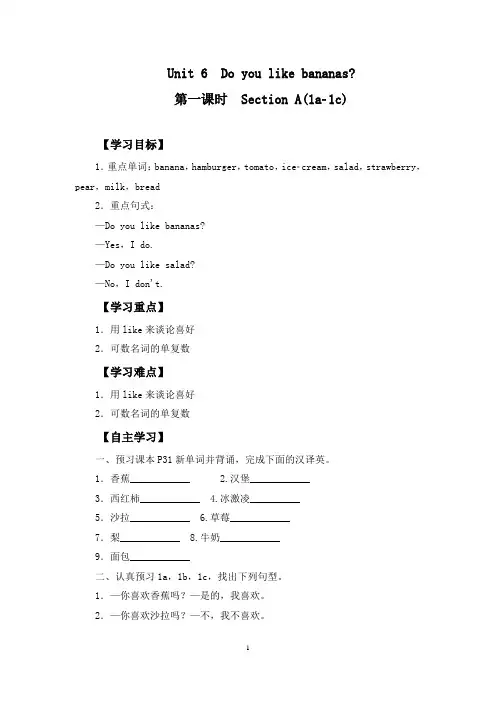
Unit 6 Do you like bananas?第一课时Section A(1a1c)【学习目标】1.重点单词:banana,hamburger,tomato,icecream,salad,strawberry,pear,milk,bread2.重点句式:—Do you like bananas?—Yes,I do.—Do you like salad?—No,I don't.【学习重点】1.用like来谈论喜好2.可数名词的单复数【学习难点】1.用like来谈论喜好2.可数名词的单复数【自主学习】一、预习课本P31新单词并背诵,完成下面的汉译英。
1.香蕉____________ 2.汉堡____________3.西红柿____________ 4.冰激凌__________5.沙拉____________ 6.草莓____________7.梨____________ 8.牛奶____________9.面包____________二、认真预习1a,1b,1c,找出下列句型。
1.—你喜欢香蕉吗?—是的,我喜欢。
2.—你喜欢沙拉吗?—不,我不喜欢。
【课堂导学】Step 1情景导入Teacher:There are many different kinds of fruits and vegetables in the world,and different people like different food.Everyone has its own taste.What kind of food do you like?What kind of food do you dislike?Today let's talk about the food we like and we dislike in Unit 6.环节说明:由学生感兴趣的话题导入新课,简洁明了,激起学生的学习兴趣。
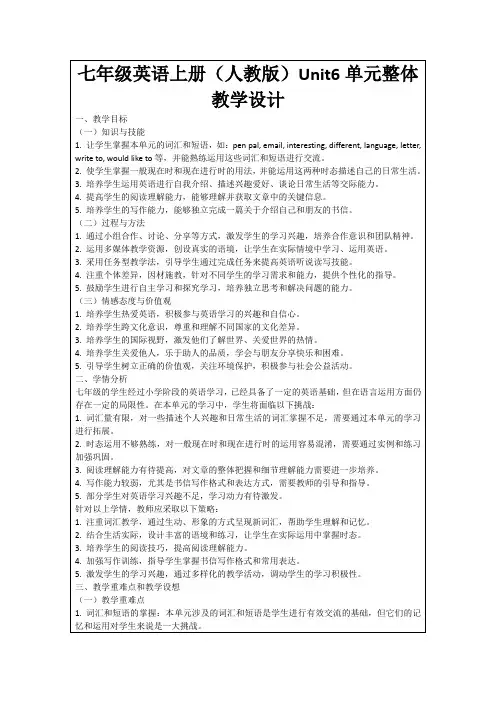
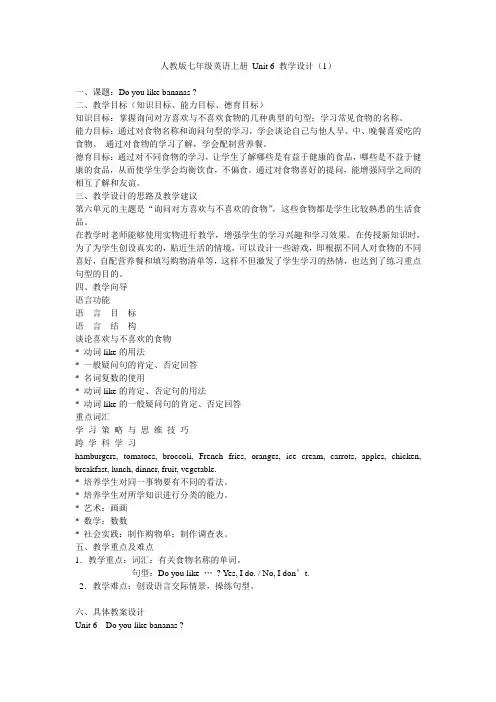
人教版七年级英语上册Unit 6 教学设计(1)一、课题:Do you like bananas ?二、教学目标(知识目标、能力目标、德育目标)知识目标:掌握询问对方喜欢与不喜欢食物的几种典型的句型;学习常见食物的名称。
能力目标:通过对食物名称和询问句型的学习,学会谈论自己与他人早、中、晚餐喜爱吃的食物。
通过对食物的学习了解,学会配制营养餐。
德育目标:通过对不同食物的学习,让学生了解哪些是有益于健康的食品,哪些是不益于健康的食品,从而使学生学会均衡饮食,不偏食。
通过对食物喜好的提问,能增强同学之间的相互了解和友谊。
三、教学设计的思路及教学建议第六单元的主题是“询问对方喜欢与不喜欢的食物”,这些食物都是学生比较熟悉的生活食品。
在教学时老师能够使用实物进行教学,增强学生的学习兴趣和学习效果。
在传授新知识时,为了为学生创设真实的,贴近生活的情境,可以设计一些游戏,即根据不同人对食物的不同喜好,自配营养餐和填写购物清单等,这样不但激发了学生学习的热情,也达到了练习重点句型的目的。
四、教学向导语言功能语言目标语言结构谈论喜欢与不喜欢的食物* 动词like的用法* 一般疑问句的肯定、否定回答* 名词复数的使用* 动词like的肯定、否定句的用法* 动词like的一般疑问句的肯定、否定回答重点词汇学习策略与思维技巧跨学科学习hamburgers, tomatoes, broccoli, French fries, oranges, ice cream, carrots, apples, chicken, breakfast, lunch, dinner, fruit, vegetable.* 培养学生对同一事物要有不同的看法。
* 培养学生对所学知识进行分类的能力。
* 艺术:画画* 数学:数数* 社会实践:制作购物单;制作调查表。
五、教学重点及难点1.教学重点:词汇:有关食物名称的单词。
句型:Do you like …? Yes, I do. / No, I don’t.2.教学难点:创设语言交际情景,操练句型。
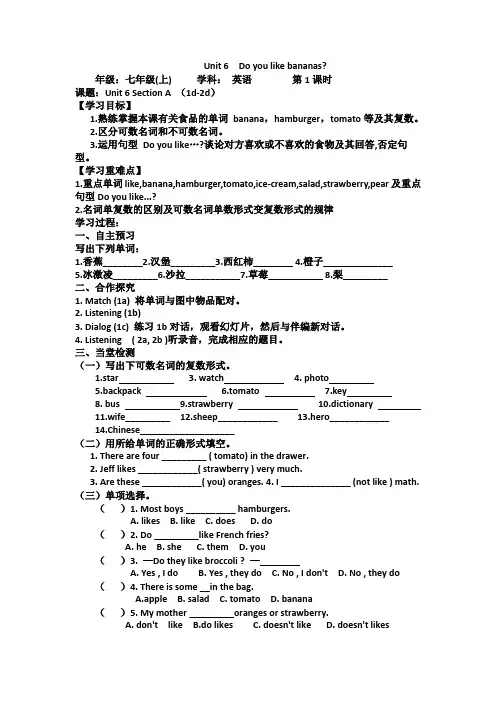
Unit 6 Do you like bananas?年级:七年级(上) 学科:英语第1课时课题:Unit 6 Section A (1d-2d)【学习目标】1.熟练掌握本课有关食品的单词banana,hamburger,tomato等及其复数。
2.区分可数名词和不可数名词。
3.运用句型Do you like…?谈论对方喜欢或不喜欢的食物及其回答,否定句型。
【学习重难点】1.重点单词like,banana,hamburger,tomato,ice-cream,salad,strawberry,pear及重点句型Do you like...?2.名词单复数的区别及可数名词单数形式变复数形式的规律学习过程:一、自主预习写出下列单词:1.香蕉________2.汉堡_________3.西红柿________4.橙子______________5.冰激凌_________6.沙拉___________7.草莓___________8.梨_________二、合作探究1. Match (1a) 将单词与图中物品配对。
2. Listening (1b)3. Dialog (1c) 练习1b对话,观看幻灯片,然后与伴编新对话。
4. Listening ( 2a, 2b )听录音,完成相应的题目。
三、当堂检测(一)写出下可数名词的复数形式。
1.star 3. watch 4. photo5.backpack6.tomato7.key8. bus 9.strawberry 10.dictionary11.wife_________ 12.sheep____________ 13.hero____________14.Chinese___________________(二)用所给单词的正确形式填空。
1. There are four _________ ( tomato) in the drawer.2. Jeff likes ____________( strawberry ) very much.3. Are these ____________( you) oranges.4. I ______________ (not like ) math. (三)单项选择。
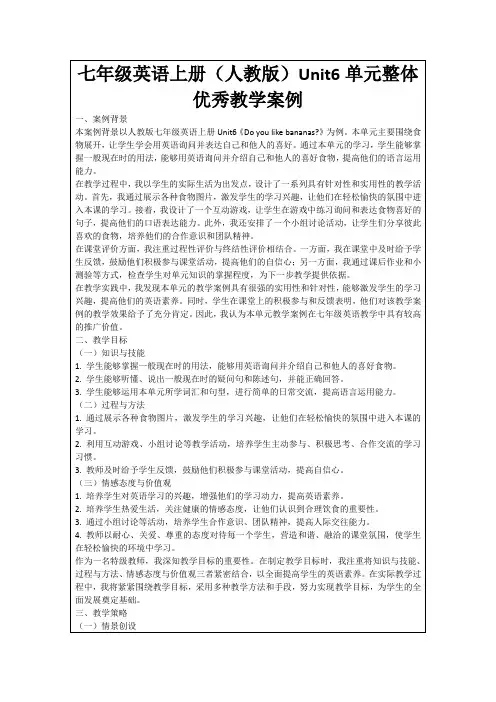
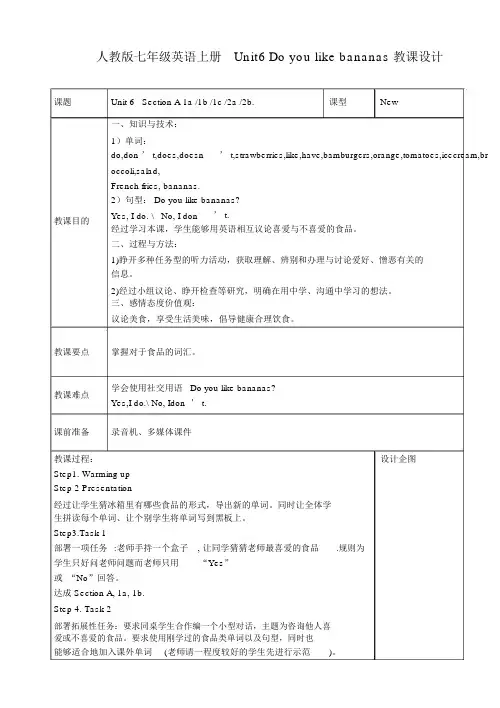
人教版七年级英语上册Unit6 Do you like bananas教课设计课题Unit 6 Section A 1a /1b /1c /2a /2b.课型New一、知识与技术:1)单词:do,don ’ t,does,doesn’ t,strawberries,like,have,bamburgers,orange,tomatoes,icecream,broccoli,salad,French fries, bananas.2)句型: Do you like bananas?教课目的Yes, I do. \ No, I don’ t.经过学习本课,学生能够用英语相互议论喜爱与不喜爱的食品。
二、过程与方法:1)睁开多种任务型的听力活动,获取理解、辨别和办理与讨论爱好、憎恶有关的信息。
2)经过小组议论、睁开检查等研究,明确在用中学、沟通中学习的想法。
三、感情态度价值观:议论美食,享受生活美味,倡导健康合理饮食。
教课要点掌握对于食品的词汇。
教课难点学会使用社交用语 Do you like bananas? Yes,I do.\ No, Idon ’ t.课前准备录音机、多媒体课件教课过程:设计企图Step1. Warming upStep 2 Presentation经过让学生猜冰箱里有哪些食品的形式,导出新的单词。
同时让全体学生拼读每个单词、让个别学生将单词写到黑板上。
Step3.Task 1部署一项任务:老师手持一个盒子, 让同学猜猜老师最喜爱的食品.规则为学生只好问老师问题而老师只用“Yes”或“No”回答。
达成 Section A, 1a, 1b.Step 4. Task 2部署拓展性任务:要求同桌学生合作编一个小型对话,主题为咨询他人喜爱或不喜爱的食品。
要求使用刚学过的食品类单词以及句型,同时也能够适合地加入课外单词(老师请一程度较好的学生先进行示范)。
Step 5.达成课文32 页 Section A 听力练习activity 2a, 2b.Setp 6.当堂听写听写单词与句型,进一步稳固本课学习内容,并将本课应掌握的单词和句型落实到“写”上,使学生不只会说同时会写。
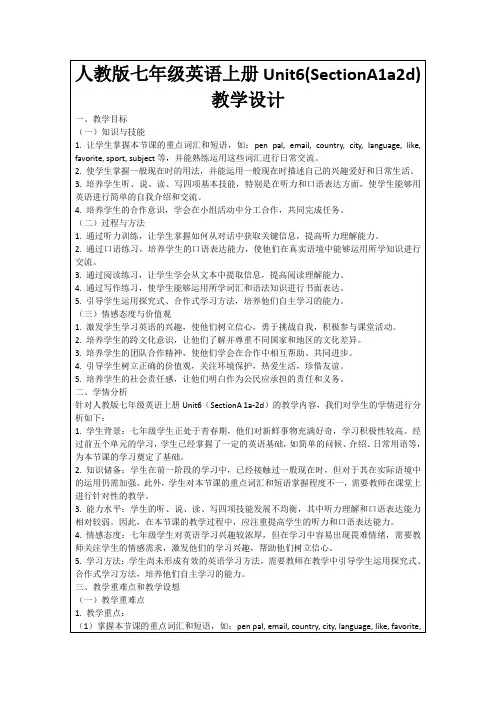
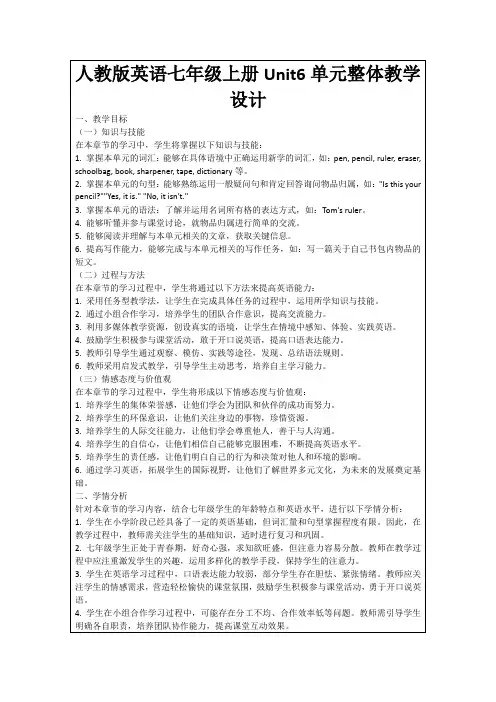
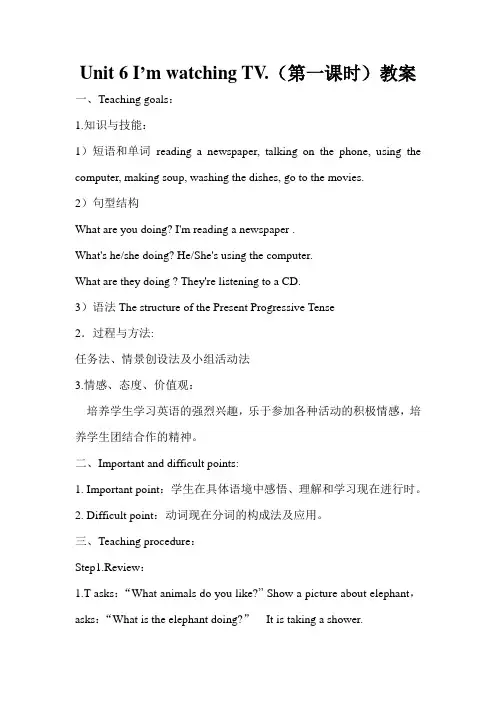
Unit 6 I’m watching TV.(第一课时)教案一、Teaching goals:1.知识与技能:1)短语和单词reading a newspaper, talking on the phone, using the computer, making soup, washing the dishes, go to the movies.2)句型结构What are you doing? I'm reading a newspaper .What's he/she doing? He/She's using the computer.What are they doing ? They're listening to a CD.3)语法The structure of the Present Progressive Tense2.过程与方法:任务法、情景创设法及小组活动法3.情感、态度、价值观:培养学生学习英语的强烈兴趣,乐于参加各种活动的积极情感,培养学生团结合作的精神。
二、Important and difficult points:1. Important point:学生在具体语境中感悟、理解和学习现在进行时。
2. Difficult point:动词现在分词的构成法及应用。
三、Teaching procedure:Step1.Review:1.T asks:“What animals do you like?” Show a picture about elephant,asks:“What is the elephant doing?”It is taking a shower.2.Show some pictures ,these pictures are from 1a.Ask: What are you doing? What's he/she doing? What are they doing ? Answer:I'm watching TV.He/She's cleaning the room/exercising.They're listening to a CD.Step2.1)Show the pictures, teach new words in 1a.2)Using the phrases in 1a to make some new sentences.3)Four students in a group, find the rules of the present participle and do some exercises.Step3.1)Show names in 1b,and ask students to guess:Who is Jenny? Who is John? Who are Dave and Mary?2) Play the recorder and complete 1b.3) Check the answers.Step4.GroupworkAsk and answer questions about what people are doing in 1a.Step5.Sum up the structure of the Present Progressive Tense and do some exercises.Step6.1.Ask students to listen and match the answers with the questions.2.Check the answers.Step7.1)Students read 2b by themselves ,and guess the answers.2) Play the recorder ,and check the answers.Step8.Groupwork:Role –play the conversation.Step9.1)Show Ss:What are Jenny and Laura doing? And ask Ss to listen to the tape.2)Sum up the making telephone calls.Eg: This is…, It’s…here? I’d love to. Let’s meet at…, Come at…, See you…。
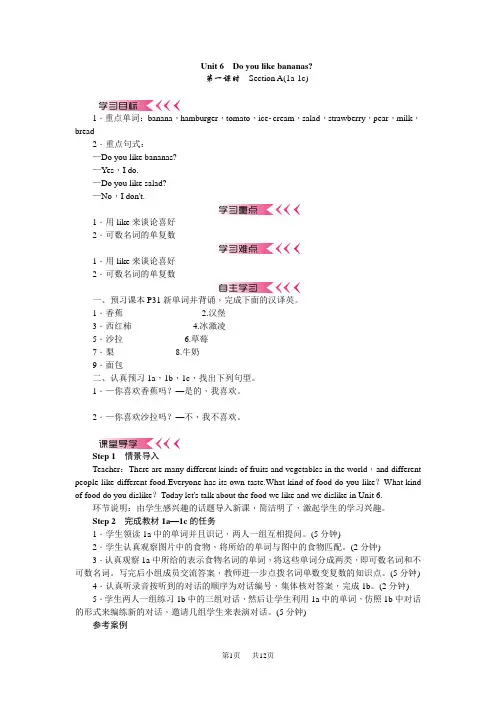
Unit 6Do you like bananas?第一课时Section A(1a-1c)1.重点单词:banana,hamburger,tomato,icecream,salad,strawberry,pear,milk,bread2.重点句式:—Do you like bananas?—Yes,I do.—Do you like salad?—No,I don't.1.用like来谈论喜好2.可数名词的单复数1.用like来谈论喜好2.可数名词的单复数一、预习课本P31新单词并背诵,完成下面的汉译英。
1.香蕉____________ 2.汉堡____________3.西红柿____________ 4.冰激凌__________5.沙拉____________ 6.草莓____________7.梨____________ 8.牛奶____________9.面包____________二、认真预习1a,1b,1c,找出下列句型。
1.—你喜欢香蕉吗?—是的,我喜欢。
________________________________________________________________________ 2.—你喜欢沙拉吗?—不,我不喜欢。
________________________________________________________________________Step 1情景导入Teacher:There are many different kinds of fruits and vegetables in the world,and different people like different food.Everyone has its own taste.What kind of food do you like?What kind of food do you dislike?Today let's talk about the food we like and we dislike in Unit 6.环节说明:由学生感兴趣的话题导入新课,简洁明了,激起学生的学习兴趣。
新人教版七年级上册英语教课设计Unit.6 Unit 6 Do you like bananas?授班授型教课目教课内容要点点学情剖析授日期新授学数The 1st period (Section A 1a — 1c)1.Learn to talk about likes and dislikes2.Learn food names3.Learn to concerned with others, formed a close friendship with others.1 New words: like, banana, hamburger, tomato, broccoli, French fries, orange, ice, cream,salad, strawberry, pear, have,2Sentence Patterns:— Do you like salad?— No, I don ’t./ Yes, I do.— Does he like pears?— Yes, he does./ No, he doesn’t.He/ She likes ⋯ .He/She doesn’tlike ⋯ .— Do you like salad?— No, I don ’t./ Yes, I do.— Does he like pears?— Yes, he does./ No, he doesn’t.He/ She likes ⋯ .He/She doesn’tlike ⋯ .教课方法学方法引入任型教课、分价法、直教课法、模拟示范法、情形教课和合作学法前、堂内外、听写合教课程注I. Warming-up and revision1 Say something about the answers to the English Papers and the Exercises.Ask the Ss to pay attention to what mistakes they have made.2 Ask some of them to read 3a on page 29 from memory.3. T: What ’ s this? ( It’ s al.soccer) balCan you use this word make sentences?Ss: Do you have a soccer ball?I have a soccer ball.Let ’ s play soccer.教课步及主要内容堂⋯I like playing socce r. I don’ t like playing soccer.II. PresentationStep 1.T:Are you free this Sunday?Ss: Yes.T: Well, let’ s go to KFC.Ss: That sounds interesting/fun⋯T: In KFC, there are much food (Show pictures of food) , what do you like?Ss: I like⋯Step 2.T: What’ s this?S: It’ s a hamburger.T: What are they?S: They ’hamburgersre.T: Do you like hamburgers?S: Yes./ No, I don’ t like(Tell Ss the short answer: Yes, I do. /No, I don’ t. )ing the same way to teach other words.Show the followings on the Bb.1.Learning the new words: Food of the section by showing slides.2. Read and try to remember them within 15 minutes.3. Talk about the Ss rite’ foodfavo.4.The use of countable and uncountable nouns.5.Do Part 2cIII. ChattingT: In KFC, I like apple pie. It’ s very delicious. Do you like apple pie? (Yes./ No) There are many pies, which pies do you like?(banana pie, strawberrypie, orange pie)T: What’ s this?S: It’ s a /an⋯.(banana, orange, strawberry)T: What are they?S: They ’ re⋯. (bananas,anges,or strawberries)IV. Healthy foodT:Apple, banana ⋯these fruit can make us keep healthy. Vegetables also canmake us healthy. So I like broccoli. Broccoli is uncountable.T:Do you known tomato is a fruit or vegetable.(Vegetable)Write them on BbV. Practice1. T: Do y ou like⋯( broccoliomatoes),Yes, I do. / No, I don’ t.2.1a Ask one student to read the words Matchthe words with the things in the picture.3.1b Listen to the tape.4 1c Pairwork(do as 1b)5 2a Ask one student to read the words. Circle the food you hear. 2b Listen again. Fill with the blank. Then read the conversation. VI. PairworkMake a conversation as Part 2bAsk the Ss to act.Unit 6 Do you like bananas?授班授型教课目教课内容要点点学情剖析授日期学数The 2nd period (Section B1a –1c)1Teach the words: food . Get the students to use them freely.2 Get the students to learn to filling the information box.New words:food, egg, apple, carrot, chicken, breakfast, lunch, dinner, fruit,Sentence Patterns or phrases:Do you like⋯? Yes, I do./ No, I don’ t.Do they like⋯? Yes, I do./ No, I don’ t.Does he / she like⋯? Yes, he/she does. / No, he/she doesn’ t. They like⋯They don’ t like⋯He/she likes⋯He/She doesn’ t like⋯Do you like⋯? Yes, I do./ No, I don’ t.Do they like⋯? Yes, I do./ No, I don’ t.Does he / she like⋯? Yes, he/she does. / No, he/she doesn’ t.They like⋯They don’ t like⋯He/she likes⋯He/She doesn’ t like⋯教课方法学方法引入任型教课、分价法、直教课法、模拟示范法、情形教课和合作学法前、堂内外、听写合教课程注I. Revision1.Greetings.2.Enjoy “ the apple ” song. T: Doyou like this song?Ss: Yes, we do.T: Do you like apples?S1: Yes, I do.T: Do you like⋯?教课步及主要内容堂堂小S2:⋯⋯T:If I go to your home, what fruit will you show me?( Help to say. )Ss: Do you like pears/peaches/ grapes/bananas/⋯?T: Yes, I do. / No, I don .’tT: Can you write down my favorite fruit?The Ss write them down. And see who write the faster and the best.II. PresentationT: Does you like⋯? S1: Yes, I do. / No, I don’ t.T: Does S1 like⋯? S2: Yes, she/he like⋯No, she/he doesn’ t like⋯Then ask the Ss to practice in group.III . Task 1.Food SurveyDo you like tomatoes, Li Lei? Yes, I do. / No, I don’ t.Name Like DislikeLi Lei tomatoes hamburgersThen report like this: Li Lei likes to matoes, but he doesn’ t like hamburgers⋯IV. Task 2.Show the pictures of the animals.T: What ’ s the favorite food?Ss: Cabbages/ bananas/ meat(chicken)/ fish⋯V. PresentationT:Li Lei likes tomatoes. But do you know what he likes for breakfast/lunch/ dinner ⋯?(Teach the new words: breakfast, lunch, dinner)Ss:⋯T: What about you? What do you like for breakfast/ lunch/ dinner?Ss: I like⋯for⋯VI. Task 3. Guessing gameShow the picture of Dave/ Helen/⋯Then Ss do like this, S1: Does Dave like apples for breakfast?S2: Yes, he does./ No, he doesn’ t.VII. Pairwork(Do Part 3,4) Section B 1b,2a,2b,2c小与作VIII. HomeworkMake a survey.( The birthday presents for your parents )What should you give your parents for their birthdays? What ’ s the best gift you have ever received? Please make up a shopping list you could use to buy本作birthday presents for your parents.Preparation:a. know about the parents’ birthdayb. know about their like and dislike food, then fill in the form授班授型教课目教课内容要点点学情剖析教课方法学方法引入教课步及主要内容本教课后(堂理念,教课成效及改想)Unit 6 Do you like bananas?授日期稳固学数The 3rd period (Section B 1a –1c)Learn to read and write an article about sb likes to eat for breakfast, lunch, dinner,and dessert.New words:run, runner, eat, star, lot, lots of, healthy, food, dessert, listrun, runner, eat, star, lot, lots of, healthy, food, dessert, list任型教课、分价法、直教课法、模拟示范法、情形教课和合作学法前、堂内外、听写合教课程注I. Revisiona. Greetingb. Free talkII. Presentationa. Show the pictures of Liu Xiang / Xing Huina / Louis /⋯.T: Do you know them? Who’ s this/ that?What are they? ( Help to say )Ss: They are running star. Liu Xiang and Xing Huina are the winners in theOlympic Games.T:Do you like them? What do they have for breakfast/ lunch/ dinner?Ss: ⋯b.Show another picture of Sandra Clark.T: What does she like for breakfast/ lunch/ dinner? Please read the text ofP35 3a quickly and find the answers.Name breakfast lunch dinner堂堂小Sandra ClarkAsk several Ss to retell the text.Tell Ss: One should eat well in breakfast, eat enough in lunch, eat less in supper.III.Writing ( 3b )Show the picture.T: What can you see in the picture? Who’ s he? What does he like to eat for breakfast/ lunch/ dinner? Please read and fill in the blank. Then check theanswers.IV . Teaching“ lots of, healthy”.a. Liu Xiang is a running star ,Xing Huina is a running star, too.In China we have a lot of running stars like them.We also have lots of other stars like film stars, TV stars, singing stars,sport stars ⋯b. Show a picture of a strong man.T:Does he look fine? Does he look healthy?c. Show the pictures of Mr Fat and Mr ThinT:Whom do you like better, why?V. TaskTask 1. Discussion: What can make you healthy?( Running, Playing sports, Eat fruit ⋯ ) Task 2. Thisweek we have learned lots of food. Some of themare healthy food, but some of them are unhealthy food. Please fill in the form.Healthy UnhealthyVI. GroupworkT: Look, the sun in shining brightly, the weather is neither too hot nor too cold.It ’ s cool. It’ s a good time for us to have a picnic. Do you want to have a picnic? What do you like/ have for the picnic?Ss: I like⋯T: Ah, so much food. OK, let’ s go. shoppingButbefore we goshopping, we should make a list, a shopping list. Now,four Ss a group to discuss, then write the shopping list.(4a)Ask the Ss report their list.小与作VII. Homework本作If you want to be healthier, which food do you think is the best for breakfast/ lunch/ dinner?本教课后(堂理念,教课成效及改想)Unit 6 Do you like bananas?讲课班级讲课种类教课目的教课内容要点难点学情剖析讲课日期复习课学时数4th period (Self –check)1.Learn to talk about likes and dislikes2.Learn food names3.Learn to concerned with others, formed a close friendship with others.1.Revise the food names. ( singular and plural )2.Revise how to inquire sb s or’dislilikes.3.Revise how to write an article which is about sb’ s likes for three meals1.Revise the food names. ( singular and plural )2.Revise how to inquire sb s or’dislilikes.3.Revise how to write an article which is about sb’ s likes for three meals教课方法学习方法课题引入教课步骤及主要内容任务型教课、分级评论法、直观教课法、模拟示范法、情形教课和合作学习法课前预习、讲堂内外练习、听闻读写联合教课过程设计备注I. Revise1.Revise the food names. ( singular and plural )2.Revise how to inquire sb s or’dislilikes.3.Revise how to write an article which is about sb ’ s likes for three meals .II. Go through self-check1.Vocabulary Revision: Check the words you know.2.Write down some new words in your notebook.3.Draw the food you like to eat for lunch.4.Ask your classmates what they like to eat for lunch. Find someone wholikes to eat the same lunch as you.讲堂练习III. Have a quiz.小结与作业讲堂小结IV . Homework本课作业 1. Finish the workbook.2.Do the exercise on the newspaper.本课教课后记(讲堂设计理念,实质教课成效及改良假想)。
人教版新目标七年级英语初一上册Unit6单元教案设计含教学反思本单元的主要目标是讨论各种食物,询问某人是否喜欢某种食物,并回答。
学生将学会描述一日三餐,以及如何合理搭配饮食,学会使用like的一般现在时、一般疑问句及肯、否定回答。
二、过程与方法本单元采用情景法、交际法和任务型教学,配合多媒体辅助教学。
通过设疑、提问、启发、诱导等方法,唤醒学生的主体意识,调动学生的积极性,全方位、多角度培养学生运用语言的能力。
三、情感态度与价值观通过研究西方食品文化,培养学生的跨文化交际意识;通过小组活动,指导学生积极与他人合作,培养合作精神;通过任务型活动,使学生学会在实际生活中均衡饮食,合理配餐。
教学过程Step 1:导入新课教师可以先向学生展示一些食物的图片,然后询问学生是否喜欢这些食物,以此引出本课的主题。
Step 2:研究新词汇教师可以通过图片和单词卡片等方式,教授本单元的新词汇,如hamburger、tomato、broccoli、French fries、orange、ice cream、salad、banana、egg、strawberry、carrot、apple、chicken、breakfast、lunch、XXX、fruit、XXX等。
Step 3:研究语言目标教师可以通过问答、听力练等方式,让学生掌握本单元的语言目标,如Do you like hamburgers。
Yes。
I do./No。
I don’t。
I like French XXX等。
Step 4:练对话教师可以让学生分组进行对话练,让他们模拟真实情境,练如何询问和回答关于食物的问题。
Step 5:完成任务教师可以让学生完成任务,如描述一日三餐,合理搭配饮食等,让学生在实际情境中应用所学知识。
Step 6:总结本课内容教师可以让学生总结本课所学内容,巩固知识点,为下一课做好准备。
教学反思本单元通过情景法、交际法和任务型教学,配合多媒体辅助教学,使学生在实际情境中应用所学知识,培养他们的语言运用能力。
新人教版七年级上册英语教案Unit.6 Unit 6 Do you like bananas?授班授型教学目教学内容重点点学情分析授日期新授学数The 1st period (Section A 1a — 1c)1.Learn to talk about likes and dislikes2.Learn food names3.Learn to concerned with others, formed a close friendship with others.1 New words: like, banana, hamburger, tomato, broccoli, French fries, orange, ice, cream,salad, strawberry, pear, have,2Sentence Patterns:— Do you like salad?— No, I don ’t./ Yes, I do.— Does he like pears?— Yes, he does./ No, he doesn’t.He/ She likes ⋯ .He/She doesn’tlike ⋯ .— Do you like salad?— No, I don ’t./ Yes, I do.— Does he like pears?— Yes, he does./ No, he doesn’t.He/ She likes ⋯ .He/She doesn’tlike ⋯ .教学方法学方法引入任型教学、分价法、直教学法、模仿示范法、情景教学和合作学法前、堂内外、听写合教学程注I. Warming-up and revision1 Say something about the answers to the English Papers and the Exercises.Ask the Ss to pay attention to what mistakes they have made.2 Ask some of them to read 3a on page 29 from memory.3. T: What ’ s this? ( It’ s al.soccer) balCan you use this word make sentences?Ss: Do you have a soccer ball?I have a soccer ball.Let ’ s play soccer.教学步及主要内容堂⋯I like playing socce r. I don’ t like playing soccer.II. PresentationStep 1.T:Are you free this Sunday?Ss: Yes.T: Well, let’ s go to KFC.Ss: That sounds interesting/fun⋯T: In KFC, there are much food (Show pictures of food) , what do you like?Ss: I like⋯Step 2.T: What’ s this?S: It’ s a hamburger.T: What are they?S: They ’hamburgersre.T: Do you like hamburgers?S: Yes./ No, I don’ t like(Tell Ss the short answer: Yes, I do. /No, I don’ t. )ing the same way to teach other words.Show the followings on the Bb.1.Learning the new words: Food of the section by showing slides.2. Read and try to remember them within 15 minutes.3. Talk about the Ss rite’ foodfavo.4.The use of countable and uncountable nouns.5.Do Part 2cIII. ChattingT: In KFC, I like apple pie. It’ s very delicious. Do you like apple pie? (Yes./ No) There are many pies, which pies do you like?(banana pie, strawberrypie, orange pie)T: What’ s this?S: It’ s a /an⋯.(banana, orange, strawberry)T: What are they?S: They ’ re⋯. (bananas,anges,or strawberries)IV. Healthy foodT:Apple, banana ⋯these fruit can make us keep healthy. Vegetables also canmake us healthy. So I like broccoli. Broccoli is uncountable.T:Do you known tomato is a fruit or vegetable.(Vegetable)Write them on BbV. Practice1. T: Do y ou like⋯( broccoliomatoes),Yes, I do. / No, I don’ t.2.1a Ask one student to read the words Matchthe words with the things in the picture.3.1b Listen to the tape.4 1c Pairwork(do as 1b)5 2a Ask one student to read the words. Circle the food you hear. 2b Listen again. Fill with the blank. Then read the conversation. VI. PairworkMake a conversation as Part 2bAsk the Ss to act.Unit 6 Do you like bananas?授班授型教学目教学内容重点点学情分析授日期学数The 2nd period (Section B1a –1c)1Teach the words: food . Get the students to use them freely.2 Get the students to learn to filling the information box.New words:food, egg, apple, carrot, chicken, breakfast, lunch, dinner, fruit,Sentence Patterns or phrases:Do you like⋯? Yes, I do./ No, I don’ t.Do they like⋯? Yes, I do./ No, I don’ t.Does he / she like⋯? Yes, he/she does. / No, he/she doesn’ t. They like⋯They don’ t like⋯He/she likes⋯He/She doesn’ t like⋯Do you like⋯? Yes, I do./ No, I don’ t.Do they like⋯? Yes, I do./ No, I don’ t.Does he / she like⋯? Yes, he/she does. / No, he/she doesn’ t.They like⋯They don’ t like⋯He/she likes⋯He/She doesn’ t like⋯教学方法学方法引入任型教学、分价法、直教学法、模仿示范法、情景教学和合作学法前、堂内外、听写合教学程注I. Revision1.Greetings.2.Enjoy “ the apple ” song. T: Doyou like this song?Ss: Yes, we do.T: Do you like apples?S1: Yes, I do.T: Do you like⋯?教学步及主要内容堂堂小S2:⋯⋯T:If I go to your home, what fruit will you show me?( Help to say. )Ss: Do you like pears/peaches/ grapes/bananas/⋯?T: Yes, I do. / No, I don .’tT: Can you write down my favorite fruit?The Ss write them down. And see who write the faster and the best.II. PresentationT: Does you like⋯? S1: Yes, I do. / No, I don’ t.T: Does S1 like⋯? S2: Yes, she/he like⋯No, she/he doesn’ t like⋯Then ask the Ss to practice in group.III . Task 1.Food SurveyDo you like tomatoes, Li Lei? Yes, I do. / No, I don’ t.Name Like DislikeLi Lei tomatoes hamburgersThen report like this: Li Lei likes to matoes, but he doesn’ t like hamburgers⋯IV. Task 2.Show the pictures of the animals.T: What ’ s the favorite food?Ss: Cabbages/ bananas/ meat(chicken)/ fish⋯V. PresentationT:Li Lei likes tomatoes. But do you know what he likes for breakfast/lunch/ dinner ⋯?(Teach the new words: breakfast, lunch, dinner)Ss:⋯T: What about you? What do you like for breakfast/ lunch/ dinner?Ss: I like⋯for⋯VI. Task 3. Guessing gameShow the picture of Dave/ Helen/⋯Then Ss do like this, S1: Does Dave like apples for breakfast?S2: Yes, he does./ No, he doesn’ t.VII. Pairwork(Do Part 3,4) Section B 1b,2a,2b,2c小与作VIII. HomeworkMake a survey.( The birthday presents for your parents )What should you give your parents for their birthdays? What ’ s the best gift you have ever received? Please make up a shopping list you could use to buy本作birthday presents for your parents.Preparation:a. know about the parents’ birthdayb. know about their like and dislike food, then fill in the form授班授型教学目教学内容重点点学情分析教学方法学方法引入教学步及主要内容本教学后(堂理念,教学效果及改想)Unit 6 Do you like bananas?授日期巩固学数The 3rd period (Section B 1a –1c)Learn to read and write an article about sb likes to eat for breakfast, lunch, dinner,and dessert.New words:run, runner, eat, star, lot, lots of, healthy, food, dessert, listrun, runner, eat, star, lot, lots of, healthy, food, dessert, list任型教学、分价法、直教学法、模仿示范法、情景教学和合作学法前、堂内外、听写合教学程注I. Revisiona. Greetingb. Free talkII. Presentationa. Show the pictures of Liu Xiang / Xing Huina / Louis /⋯.T: Do you know them? Who’ s this/ that?What are they? ( Help to say )Ss: They are running star. Liu Xiang and Xing Huina are the winners in theOlympic Games.T:Do you like them? What do they have for breakfast/ lunch/ dinner?Ss: ⋯b.Show another picture of Sandra Clark.T: What does she like for breakfast/ lunch/ dinner? Please read the text ofP35 3a quickly and find the answers.Name breakfast lunch dinner堂堂小Sandra ClarkAsk several Ss to retell the text.Tell Ss: One should eat well in breakfast, eat enough in lunch, eat less in supper.III.Writing ( 3b )Show the picture.T: What can you see in the picture? Who’ s he? What does he like to eat for breakfast/ lunch/ dinner? Please read and fill in the blank. Then check theanswers.IV . Teaching“ lots of, healthy”.a. Liu Xiang is a running star ,Xing Huina is a running star, too.In China we have a lot of running stars like them.We also have lots of other stars like film stars, TV stars, singing stars,sport stars ⋯b. Show a picture of a strong man.T:Does he look fine? Does he look healthy?c. Show the pictures of Mr Fat and Mr ThinT:Whom do you like better, why?V. TaskTask 1. Discussion: What can make you healthy?( Running, Playing sports, Eat fruit ⋯ ) Task 2. Thisweek we have learned lots of food. Some of themare healthy food, but some of them are unhealthy food. Please fill in the form.Healthy UnhealthyVI. GroupworkT: Look, the sun in shining brightly, the weather is neither too hot nor too cold.It ’ s cool. It’ s a good time for us to have a picnic. Do you want to have a picnic? What do you like/ have for the picnic?Ss: I like⋯T: Ah, so much food. OK, let’ s go. shoppingButbefore we goshopping, we should make a list, a shopping list. Now,four Ss a group to discuss, then write the shopping list.(4a)Ask the Ss report their list.小与作VII. Homework本作If you want to be healthier, which food do you think is the best for breakfast/ lunch/ dinner?本教学后(堂理念,教学效果及改想)Unit 6 Do you like bananas?授课班级授课类型教学目标教学内容重点难点学情分析授课日期复习课学时数4th period (Self –check)1.Learn to talk about likes and dislikes2.Learn food names3.Learn to concerned with others, formed a close friendship with others.1.Revise the food names. ( singular and plural )2.Revise how to inquire sb s or’dislilikes.3.Revise how to write an article which is about sb’ s likes for three meals1.Revise the food names. ( singular and plural )2.Revise how to inquire sb s or’dislilikes.3.Revise how to write an article which is about sb’ s likes for three meals教学方法学习方法课题引入教学步骤及主要内容任务型教学、分级评价法、直观教学法、模仿示范法、情景教学和合作学习法课前预习、课堂内外练习、听说读写结合教学过程设计备注I. Revise1.Revise the food names. ( singular and plural )2.Revise how to inquire sb s or’dislilikes.3.Revise how to write an article which is about sb ’ s likes for three meals .II. Go through self-check1.Vocabulary Revision: Check the words you know.2.Write down some new words in your notebook.3.Draw the food you like to eat for lunch.4.Ask your classmates what they like to eat for lunch. Find someone wholikes to eat the same lunch as you.课堂练习III. Have a quiz.小结与作业课堂小结IV . Homework本课作业 1. Finish the workbook.2.Do the exercise on the newspaper.本课教学后记(课堂设计理念,实际教学效果及改进设想)。